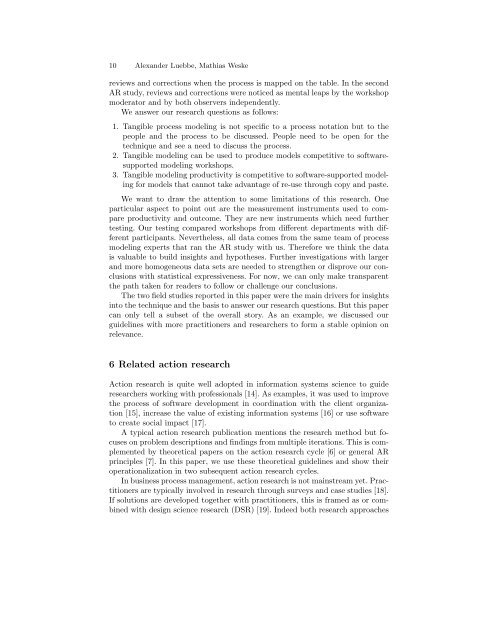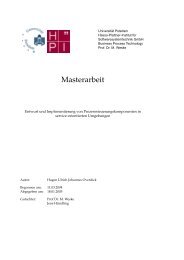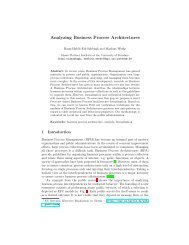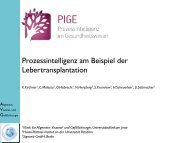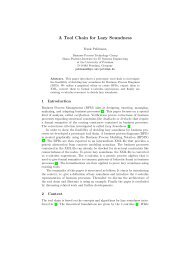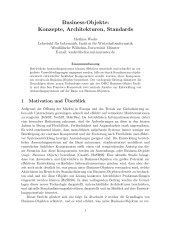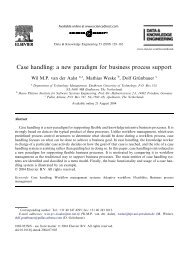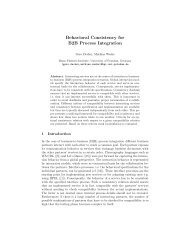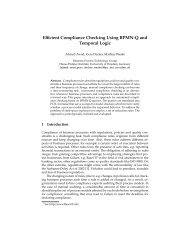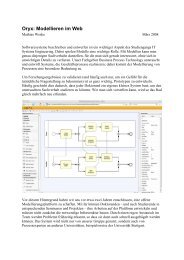Investigating Process Elicitation Workshops using Action Research
Investigating Process Elicitation Workshops using Action Research
Investigating Process Elicitation Workshops using Action Research
Create successful ePaper yourself
Turn your PDF publications into a flip-book with our unique Google optimized e-Paper software.
10 Alexander Luebbe, Mathias Weske<br />
reviews and corrections when the process is mapped on the table. In the second<br />
AR study, reviews and corrections were noticed as mental leaps by the workshop<br />
moderator and by both observers independently.<br />
We answer our research questions as follows:<br />
1. Tangible process modeling is not specific to a process notation but to the<br />
people and the process to be discussed. People need to be open for the<br />
technique and see a need to discuss the process.<br />
2. Tangible modeling can be used to produce models competitive to softwaresupported<br />
modeling workshops.<br />
3. Tangible modeling productivity is competitive to software-supported modeling<br />
for models that cannot take advantage of re-use through copy and paste.<br />
We want to draw the attention to some limitations of this research. One<br />
particular aspect to point out are the measurement instruments used to compare<br />
productivity and outcome. They are new instruments which need further<br />
testing. Our testing compared workshops from different departments with different<br />
participants. Nevertheless, all data comes from the same team of process<br />
modeling experts that ran the AR study with us. Therefore we think the data<br />
is valuable to build insights and hypotheses. Further investigations with larger<br />
and more homogeneous data sets are needed to strengthen or disprove our conclusions<br />
with statistical expressiveness. For now, we can only make transparent<br />
the path taken for readers to follow or challenge our conclusions.<br />
The two field studies reported in this paper were the main drivers for insights<br />
into the technique and the basis to answer our research questions. But this paper<br />
can only tell a subset of the overall story. As an example, we discussed our<br />
guidelines with more practitioners and researchers to form a stable opinion on<br />
relevance.<br />
6 Related action research<br />
<strong>Action</strong> research is quite well adopted in information systems science to guide<br />
researchers working with professionals [14]. As examples, it was used to improve<br />
the process of software development in coordination with the client organization<br />
[15], increase the value of existing information systems [16] or use software<br />
to create social impact [17].<br />
A typical action research publication mentions the research method but focuses<br />
on problem descriptions and findings from multiple iterations. This is complemented<br />
by theoretical papers on the action research cycle [6] or general AR<br />
principles [7]. In this paper, we use these theoretical guidelines and show their<br />
operationalization in two subsequent action research cycles.<br />
In business process management, action research is not mainstream yet. Practitioners<br />
are typically involved in research through surveys and case studies [18].<br />
If solutions are developed together with practitioners, this is framed as or combined<br />
with design science research (DSR) [19]. Indeed both research approaches


